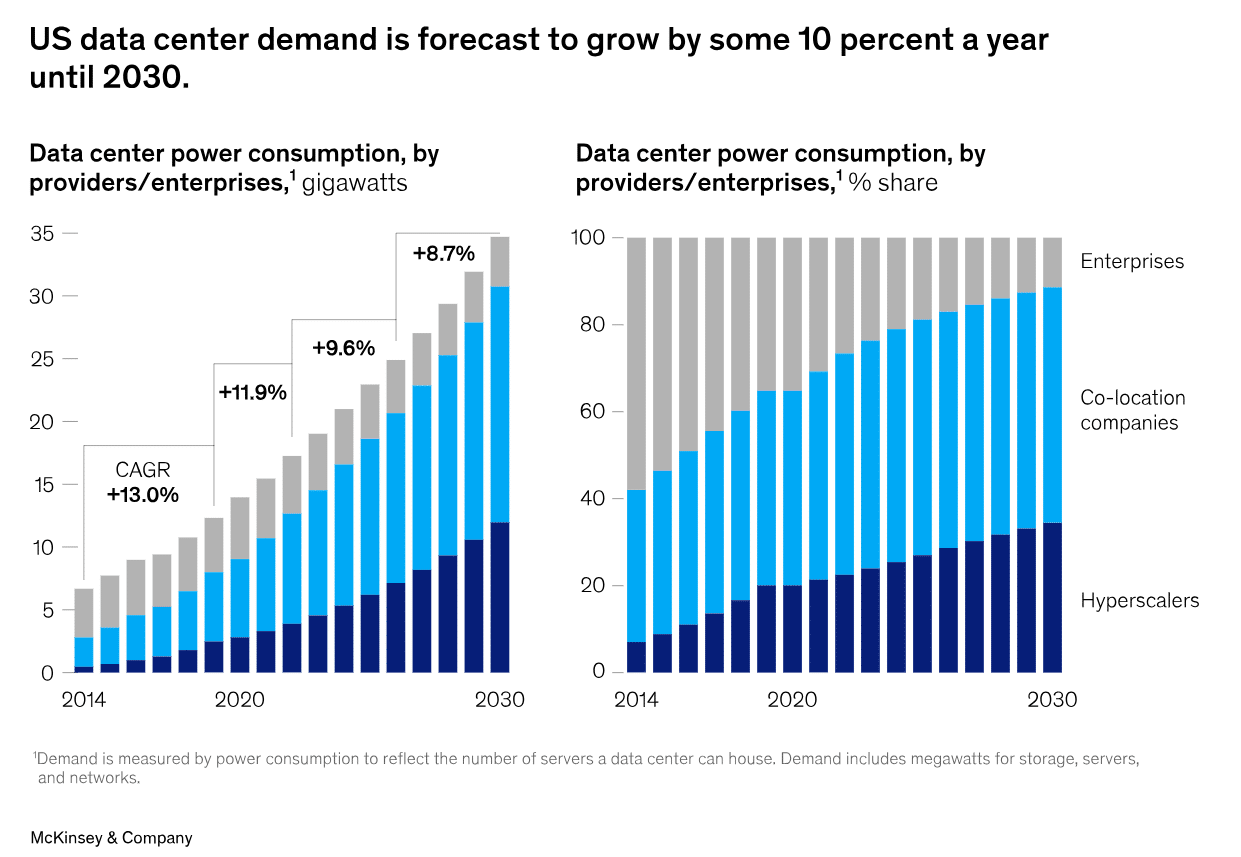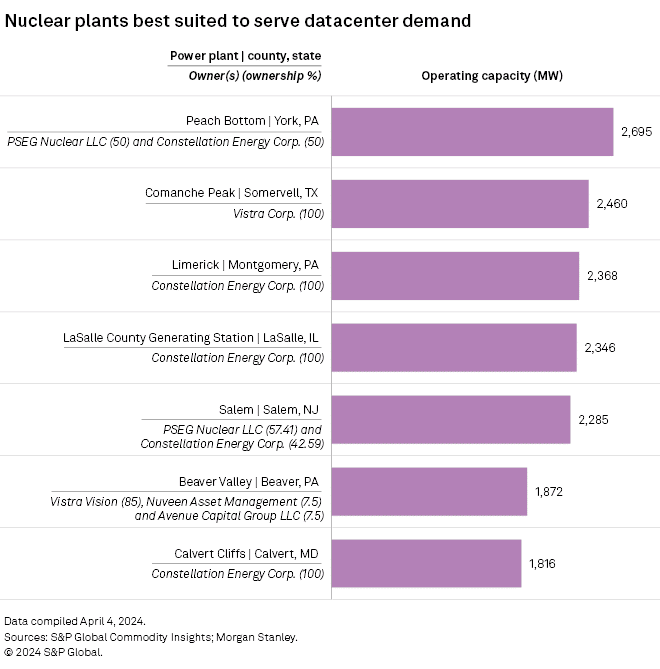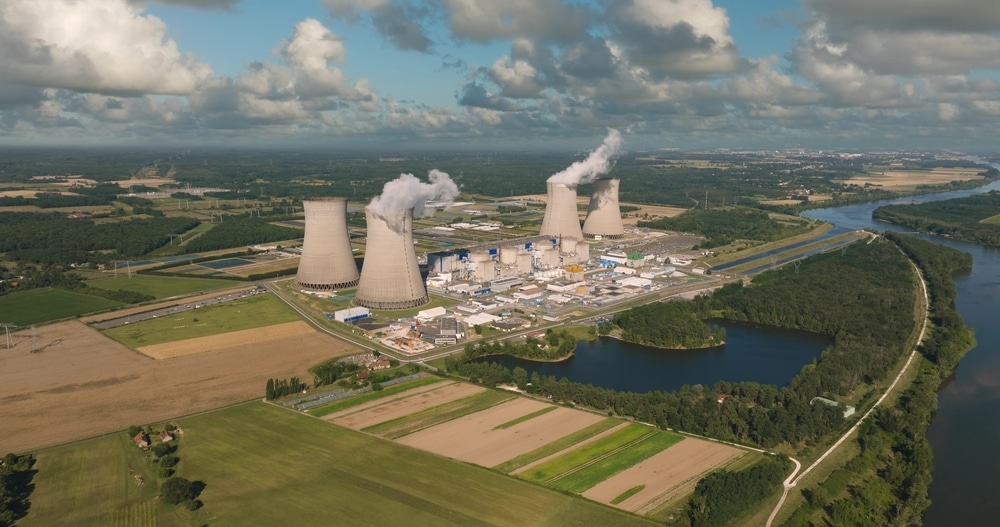Constellation Energy Corporation, the biggest nuclear power operator in the United States, is exploring the possibility of constructing new nuclear capacity at its existing reactor sites to meet the growing demand from data center customers.
Power Surge: Meeting Data Centers’ Demand
Amid the generative artificial intelligence (AI) gold rush, renewed discussions about longstanding power sources for data centers have emerged.
McKinsey’s recent forecast predicts a significant surge in data center power consumption in the U.S., from 17 gigawatts (GW) in 2022 to 35 GW in 2030. This growth is attributed in part to the increasing use of higher-power chips for demanding workloads such as AI.

The rise in power consumption per rack, from 10 kilowatts to over 60 kilowatts, has led to a doubling of overall campus capacity from 50 megawatts to over 100 megawatts over the past 5 years.
Notably, certain data center hubs like Ashburn in Northern Virginia have reached their power capacity limits. They are no longer able to accommodate requests for additional capacity. Market experts highlighted that power is the industry’s biggest challenge.
Data centers are notorious energy consumers, with a single hyperscaler’s data center consuming as much power as 80,000 households. This has put huge pressure on the industry to adopt sustainable practices, leading to the imposition of sustainability standards by regulators and governments on newly constructed data centers.
For investors, this presents opportunities to support data centers in securing low-carbon energy supplies. And this is where nuclear power could play a role.
Constellation Energy CEO Joseph Dominguez mentioned considering small modular reactors (SMRs) or other technologies and expressed interest in a multi-tiered structure with tech companies like Microsoft and Google to fund site development and construction.
The partnership aims to accelerate the development of various projects by developing new commercial structures. These include advanced nuclear, next-generation geothermal, clean hydrogen, and long-duration energy storage.
Tech Giants and Nuclear Solutions
The S&P 500 company plans to perform due diligence and achieve regulatory milestones before the electricity supply is needed. Dominguez said that they have potential projects ramping up by 2026-2028. He further added that:
“We’re in advanced conversations with multiple clients, large — well-known companies that you all know — about powering their needs… While we’re not done yet, I do expect that we will finalize agreements that will have long-term and transformational value.”
They have customers interested in behind-the-meter capacity and are exploring options with existing assets like the Calvert Cliffs, Salem, LaSalle, Limerick, and Peach Bottom plants.
Top hyperscalers, including Amazon‘s AWS, Microsoft, Meta, and Alphabet, continue to expand their data center presence. In March, Talen Energy sold a 960-megawatt data center campus to AWS for $650 million on its Pennsylvania nuclear facility.
Constellation Energy’s CEO remarks coincide with the company’s remarkable Q1 earnings, which surged by 858% to $2.78 per share. Despite a revenue decline of 18% to $6.16 billion, adjusted earnings grew by 133% to $1.82 per share. This beat analysts’ expected earnings per share of $1.30 and total sales of $6.62 billion.
The company’s stock is up over 80% in 2024. This year, it’s one of the best-performing stocks in the S&P 500 index, right next to Nvidia and Super Micro Computer.
The U.S.’ largest nuclear power plant operator also reiterated its full-year adjusted earnings guidance of $7.23 to $8.03 per share. The company holds a significant stake, owning 25% of U.S. nuclear power reactors.
Additionally, it serves as an energy provider to over 20% of the major commercial and industrial customers nationwide.
Nuclear’s Role in Data Center Sustainability
To meet their carbon-free energy targets, data center operators increasingly enter into power purchase agreements (PPAs) with renewable energy suppliers. Meanwhile, major cloud providers are taking proactive steps to finance the construction of renewable energy facilities due to rising prices caused by supply constraints.
- For instance, Amazon has backed Scottish Power’s wind farm in the UK and committed to purchasing its entire 50-megawatt output.
However, relying solely on renewables presents challenges. Solar and wind power are intermittent, often requiring fossil fuel backups. Some companies explore “24/7” PPAs, combining carbon-free sources with stored renewable energy, but at a higher cost due to expensive storage technologies.
While lithium-ion batteries are a developed backup solution, they can be costly over time. Emerging long-duration storage options like hydrogen and green ammonia energy could reduce costs but are still in the early stages.
Nuclear power offers a solution, providing reliable baseload power traditionally supplied by fossil fuels. As the sector commits to carbon neutrality, onsite nuclear power emerges as an ideal choice, meeting the energy needs of data centers efficiently and sustainably.
According to S&P Global Commodity Insights data, the following are the best nuclear plants that could provide power for data centers.

As data center power demands soar, Constellation Energy’s nuclear ambitions highlight the need for innovative energy solutions to support the digital revolution sustainably.

